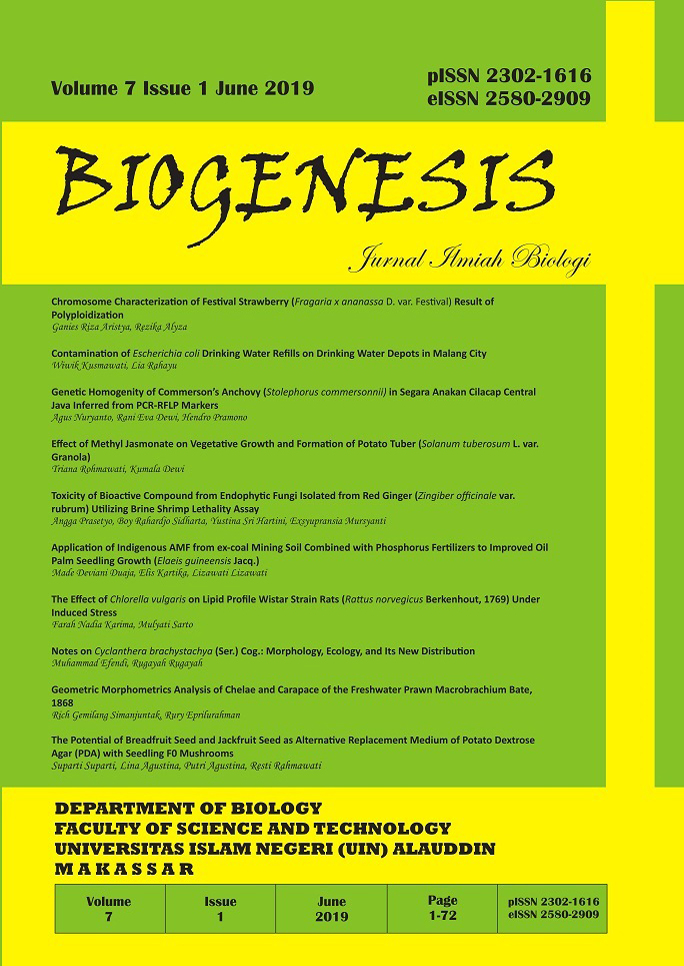Geometric Morphometrics Analysis of Chelae and Carapace of the Freshwater Prawn Macrobrachium Bate, 1868
Abstract
The shape of chelae and carapace can be used to distinguish between species of prawn. This study aims to determine the variations in the shape of chelae and carapace in several species belonging to the genus Macrobrachium using analysis of geometric morphometric. This study uses photos of specimens that have been processed with several TPS software. Data analyzed statistically by PCA using the MorphoJ software. Clustering analysis using UPGMA method using PAST software. The results showed the carapace shape grid deformation varied at the tip of the rostrum, the tip of the ocular spine and the lower curvature of the front of the carapace, and the base spines of rostrum. Grid deformation in the shape of chelae varies at the tip of the pollex, the junction between the pollex and the manus on the inferior margin of the propodus, the upper and lower points marking the junction of the dactylus with the propodus. PCA shows the total variation of the carapace shape is 82.66% which is divided into PC1: 75.11% and PC2: 7.55%. While the total variation of the shape of chelae is 87.56% which is divided into PC1: 55.49% and PC2: 32.07%. Clustering analysis shows the grouping of populations of Macrobrachium, the first group is M. latidactylus and M. sintangense, the second group includes M. horstii and M. latimanus. M. lar is a species that shows the similarity of the shape of the carapace and chelae with the two groups. M. rosenbergii and M. pilimanus are on different lines.
References
Adam DC, Rohlf FJ, Slice DE. 2004. Geometric morphometrics: Ten years of progress following the ‘revolution. Italian Journal of Zoology. vol 71(1): 5-16. doi: https://doi.org/10.1080/11250000409356545.
Adams DC, Rohlf FJ and Slice DE. 2013. A field comes of age: Geometric morphometrics in the 21st century. Hystrix. vol 24 (1): 7–14. doi: https://doi.org/10.4404/hystrix-24.1-6283.
Bookstein FL. 1991. Morphometric Tools for Landmark Data: Geometry and Biology. New York: Cambridge University Press. (xvii): 435. doi: https://doi.org/10.1017/CBO9780511573064.
Claverie T and Smith I. 2010. Allometry and sexual dimorphism in the chela shape in the squat lobster Munida rugosa. Aquatic Biology. vol 8: 179-187. doi: https://doi.org/10.3354/ab00233.
Klingenberg CP. 2011. MorphoJ: An integrated software package
for geometric morphometrics. Molecular Ecology Resources. vol 11(2): 353–357. doi: https://doi.org/10.1111/j.1755- 0998.2010.02924.x.
Klingenberg CP. 2013. Visualizations in geometric morphometrics:
How to read and how to make graphs showing shape changes.
Associazione Teriologica Italiana. Hystrix, the Italian Journal of Mammalogy. vol 24(1): 15–24. doi: https://doi.org/10.4404/hystrix-24.1-7691.
Mann AM. 2007. A Taxonomic Investigation of the Black Ratsnake, Elaphe o. obsoleta (Say) [Reptilia, Squamata, Colubridae], in West Virginia using Morphometric Analyses. [Thesis]. Huntington: The Graduate College of Marshall University.
Mitteroecker P and Gunz P. 2009. Advances in Geometric morphometrics. Evolutionary Biology. vol 36 (2): 235-247. doi: https://doi.org/10.1007/s11692-009-9055-x.
New MB. 2002. Farming Freshwater Prawn. A manual for the culture of the giant river prawn (Macrobrachium rosenbergii). FAO Fisheries Technical Paper (428). Rome. p. 1-3.
Rohlf FJ and Slice DE. 1990. Extensions of the Procrustes Method for the Optimal Superimposition of Landmark. Systematic Zoology. vol 39 (1): 40-59. doi: https://doi.org/10.2307/2992207.
Rohlf FJ. 2004. tpsSplin Version 1.20. Stony Brook (US): New York: Department of Ecology and Evolution-State University.
Rohlf FJ. 2016. tpsRelw Version 1.53. Stony Brook (US): New York: Department of Ecology and Evolution-State University.
Rufino M, Abelló P, Yule AB. 2009. Male and female carapace shape differences in Liocarcinus depurator (Decapoda, Brachyura): An application of geometric morphometric analysis to crustaceans. Italian Journal of Zoology. vol 71(1): 79-83. doi: https://doi.org/10.1080/11250000409356554.
Valencia DM and Campos MR. 2007. Freshwater prawns of the genus Macrobrachium Bate, 1868 (Crustacea: Decapoda: Palaemonidae) of Colombia. Magnolia Press. Zootaxa. vol 1456: 1–44. doi: http://dx.doi.org/10.11646/zootaxa.1456.1.
Zelditch ML, Swiderski DL, Sheets HD, and Fink WL. 2004. Geometric morphometrics for biologists: A primer. Elsevier Academic Press San Diego. vol. 95, p. 443. doi: https://doi.org/10.1016/B978-0-12-386903-6.00001-0.
Zelditch ML, Swiderski DL, and Sheets HD. 2012. Geometric morphometrics for biologists: A primer second edition. Geometric Morphometrics for Biologists. pp. 1–475. doi: https://doi.org/10.1016/B978-0-12-386903-6.00001-0.
Zimmermann G, Bosc P, Valade P, Cornette R, Ame ´ziane N, and Debat V. 2011. Geometric morphometrics of carapace of Macrobrachium australe (Crustacea: Palaemonidae) from Reunion Island. Acta Zoologica. vol 93 (4): 492–500. doi: https://doi.org/10.1111/j.1463 6395.2011.00524.x
Copyright (c) 2019 Rich Gemilang Simanjuntak, Rury Eprilurahman

This work is licensed under a Creative Commons Attribution 4.0 International License.
COPYRIGHT AND LICENSE STATEMENT
COPYRIGHT
Biogenesis: Jurnal Ilmiah Biologi is published under the terms of the Creative Commons Attribution license. Authors hold the copyright and retain publishing rights without restriction to their work. Users may read, download, copy, distribute, and print the work in any medium, provided the original work is properly cited.
LICENSE TO PUBLISH
1. License
The use of the article will be governed by the Creative Commons Attribution license as currently displayed on http://creativecommons.org/licenses/by/4.0.
2. Author’s Warranties
The author warrants that the article is original, written by stated author/s, has not been published before, contains no unlawful statements, does not infringe the rights of others, is subject to copyright that is vested exclusively in the author and free of any third party rights, and that any necessary written permissions to quote from other sources have been obtained by the author(s).
3. User Rights
Under the Creative Commons Attribution license, the users are free to download, reuse, reprint, modify, distribute and/or copy the content for any purpose, even commercially, as long as the original authors and source are cited. No permission is required from the authors or the publishers.
4. Co-Authorship
If the article was prepared jointly with other authors, the corresponding author warrants that he/she has been authorized by all co-authors, and agrees to inform his/her co-authors of the terms of this statement.
5. Miscellaneous
Biogenesis: Jurnal Ilmiah Biologi may conform the article to a style of punctuation, spelling, capitalization, and usage that it deems appropriate. The author acknowledges that the article may be published so that it will be publicly accessible and such access will be free of charge for the readers.


